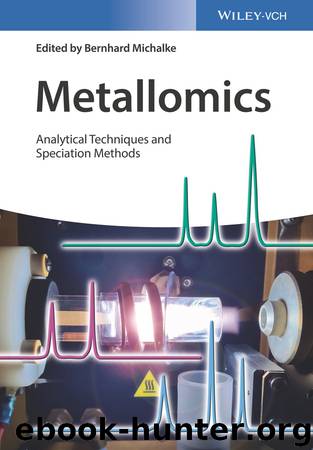Metallomics by Michalke Bernhard

Author:Michalke, Bernhard
Language: eng
Format: epub
ISBN: 9783527694914
Publisher: John Wiley & Sons, Inc.
Published: 2016-08-17T00:00:00+00:00
Chapter 8
Analytical Procedures for Speciation of Chromium, Aluminum, and Tin in Environmental and Biological Samples
Radmila Milačič, Tea Zuliani, Janja Vidmar and Janez Ščančar
8.1 Speciation of Chromium
Chromium (Cr) is a naturally occurring element commonly found in rocks and soils and is also present in living organisms. Cr is a transition metal with electronic configuration [Ar]4s13d5, which enables the highest oxidation state 6+. In metallic form, Cr is present in the zerovalent state, while in the environment, thermodynamically the most stable are trivalent (Cr(III)) and hexavalent (Cr(VI)) species. With an average concentration of 100 mg kg−1, Cr is the 22nd most abundant element of the Earth's crust. Cr and Cr compounds are widely used in steel production and metallurgy, chemical industry, leather tanning, protection and decorative coatings, automotive industry, pigment manufacture, and wood treatment. Due to such extensive use, large amounts of Cr are released into the atmosphere and terrestrial and aquatic environment [1]. As a consequence of intensive industrial activities, large amounts of Cr-rich waste materials are generated. Wastes from steel-making industry may often be reused in civil engineering, while other Cr-containing waste materials are in general disposed [2]. In nature, under environmental conditions, Cr(III) species prevail, while Cr(VI) compounds are mainly of anthropogenic origin.
The essentiality and toxicity of Cr depend primarily on its chemical forms. In general, Cr(III) compounds are far less toxic than Cr(VI). Cr(III) is an essential micro nutrient involved in glucose and lipid metabolism. The recommended daily intake of Cr(III) in humans is about 200 µg. Cr(VI) compounds are carcinogenic, mutagenic, and inducers of skin dermatitis [3].
For minimizing the health hazards of Cr(VI) to occupationally exposed workers, Occupational Safety and Health Administration set exposure limits for Cr(VI) compounds at workplace [4]. Cr(VI) usage is limited by different regulative acts [5], and measures are also taken to diminish the environmental impacts of disposed and reused Cr waste materials [2]. Concern about the potential health risk and adverse effects to living organisms resulted in severe legislative restrictions of Cr(VI) content in drinking and surface waters. California Environmental Protection Agency set the threshold limit for Cr(VI) in drinking water to 2 µg l−1 [6], while the maximum allowable concentration of Cr(VI) in inland surface waters, regulated by European Commission Communities, was set to 3.4 µg Cr(VI) l−1 [7].
The behavior of Cr in a given environmental compartment depends on the pH, Cr concentration, hydrolysis and redox reactions, adsorption/desorption processes, and/or complexation. In the aquatic environment in acidic solutions at pH lower than 4, Cr(III) exists as hexa-aqua Cr(H2O)63+ complex (abbreviated as Cr3+). In less acidic solution, hydrolysis yields Cr(H2O)5(OH)2+ (abbreviated as Cr(OH)2+) and Cr(H2O)4(OH)2+ (abbreviated as Cr(OH)2+) species, while in the neutral and alkaline pH region, Cr mainly precipitates as a sparingly soluble Cr(OH)3(s). In highly alkaline solutions, at pH higher than 11.5, the Cr(OH)3 precipitate is redissolved, which results in the formation of tetrahydroxo Cr(OH)4− complex. The speciation of Cr(VI) in aqueous solutions depends on the pH. At pH below 1, H2CrO4 acid prevails, within the pH range from 1 to 6.
Download
This site does not store any files on its server. We only index and link to content provided by other sites. Please contact the content providers to delete copyright contents if any and email us, we'll remove relevant links or contents immediately.
Alchemy and Alchemists by C. J. S. Thompson(3296)
The Elements by Theodore Gray(2852)
The Club by A.L. Brooks(2747)
How to Make Your Own Soap by Sally Hornsey(2742)
Drugs Unlimited by Mike Power(2485)
Wheels of Life by Anodea Judith(1919)
Cracking the Sat French Subject Test, 2013-2014 Edition by The Princeton Review(1767)
Perfume by Jean-Claude Ellena(1739)
The Flavor Matrix by James Briscione(1714)
The Cosmic Machine: The Science That Runs Our Universe and the Story Behind It by Scott Bembenek(1693)
Cracking the LSAT, 2012 Edition by Princeton Review(1692)
MCAT Physics and Math Review by Princeton Review(1568)
1000 Multiple-Choice Questions in Organic Chemistry by Organic Chemistry Academy(1566)
The Thing Around Your Neck by Chimamanda Ngozi Adichie(1481)
Cracking the SAT Premium Edition with 6 Practice Tests, 2017 by Princeton Review(1480)
Handbook of Modern Sensors by Jacob Fraden(1477)
A is for Arsenic: The Poisons of Agatha Christie (Bloomsbury Sigma) by Kathryn Harkup(1455)
Synchrotron Light Sources and Free-Electron Lasers by Eberhard J. Jaeschke Shaukat Khan Jochen R. Schneider & Jerome B. Hastings(1454)
Harry Potter All Books: 8 Books by J.k.rowling(1436)
